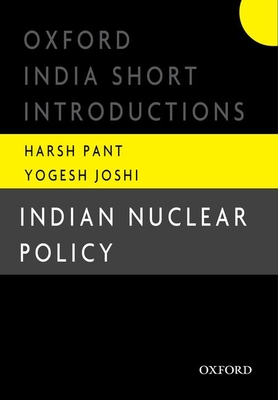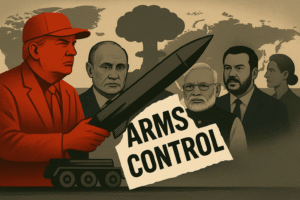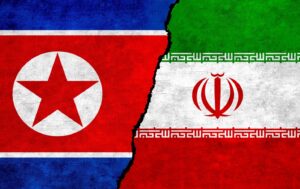Oxford India Short Introductions: Indian Nuclear Policy

The Oxford Introduction to India: Indian Nuclear Policy, by Harsh V. Pant and Yogesh Joshi, consist of five chapters, each of which offers a detailed overview of India’s nuclear policy. The book traces the historical development of India’s nuclear stance from its early days as a nuclear weapons state and highlights key developments over time. It explores the strategic, political, and operational aspects of India’s nuclear policy and how they are shaped by both international and domestic events that influence its approach to disarmament.
According to the author, India’s nuclear policy is influenced by four factors: nature, security, national policy, and personal responsibility. They point out that India has been unique since Nehru’s days as prime minister and its nuclear program began, arguing that some “moral excellence” had managed to take root in India without recourse to violence in the past. The history of India’s appearance on the world scene in the atomic age is interesting for studying Indian nuclear policy.
Harsh V. Pant and Yogesh Joshi analyze India’s march towards atomic energy and disclose its special and reluctant approach towards nuclear power. Pant and Joshi provide a historical overview of the global and regional politics surrounding India’s atomic program. The author selects a time-based approach, explaining how the development of Indian nuclear policy evolved. The major points emphasized in the book demonstrate how successful presidents engage with social as well as political issues while elites compete for influence within India. Pant & Joshi offer us an insight into the minds of Jawaharlal Nehru and Homi Jehangir Bhabha, who were leading figures behind this country’s nuclear policies.
The book shows that, unlike other countries, India has no fissile material, only thorium-rich monzonite sands. The author even gives interesting details about Bhabha’s three-phase plan to overcome India’s divisible product shortages with less outsourcing. India will use natural uranium from other sources to fuel the first stage of the reactor. Reprocessing the fuel used, along with natural uranium and Indian thorium, in the second-stage breeder reactor will produce fissile materials that will eventually power the third-stage reactor.
The focus of the Indian Nuclear Program is almost entirely on the military aspects of the program. “India’s nuclear weapons program has been an offshoot of its atomic energy program,” the author states (p. 11). This may have been the intention, but it certainly has not been the outcome. According to Tim Willasey-Wisser’s estimate of 2019, India’s nuclear power stations produce only 3.2% of the country’s energy needs. This failure has necessitated India to import hydrocarbons at significant expense from the Middle East and Africa, while also increasing the consumption of its indigenous (and often inferior quality) coal to the detriment of the environment.
India wanted to develop nuclear weapons from the beginning. Regarding the military use of atomic energy, Jawaharlal Nehru said on June 26, 1947, more than a year before independence from Britain:
“As long as the world is constituted as it is, every country will have to devise and use the latest scientific devices for its protection. I do not doubt that India will develop its scientific research, and I hope Indian scientists will use the atomic force for constructive purposes. But if India is threatened, she will inevitably try to defend herself by all means at her disposal”.
He launched a nuclear policy within 8 months of independence, and in 1974, his daughter Indira Gandhi approved India’s first nuclear test. It was designated as a “Peaceful Nuclear Explosion (PNE)”, purportedly for massive civil engineering projects such as mining or river diversion. Nobody outside India accepted this description, and the result was a significant loss of international support.
This made progress toward building a civil program and a workable weapon system much harder, and it was not until 1998 that India truly became a nuclear weapons state. In truth, India’s quest for nuclear weapons was driven by the same motives as all the other nuclear powers: self-defense, deterrence, “power and privilege”. China’s nuclear test in 1964 and Pakistan’s program provided India with crucial motivation.
Latterly, the arrival of the Bharatiya Janta Party’s (BJP) government has also led to a less morally contorted and more pragmatic position towards India’s nuclear weapons. India is now advancing a formidable array of capabilities, encompassing missiles, aircraft, and ballistic missile submarines. The authors point out, “India took 10 years to respond to the first Chinese nuclear test in October 1964; and when India first tested a nuclear device in 1974, it called it a peaceful nuclear explosion (PNE) and followed a policy of ‘nuclear refrain’ (p. 11). Another twenty-four years would pass until India conducted its own nuclear weapons test.
The Indian prime ministers and the leading scientists continued to play major roles through the decades of development. Pant and Joshi note that India was actively involved in the development of multiple nuclear-related treaties during the nuclear program. India would fight hard for favorable clauses in those treaties and agreements, but then frequently fail to sign because the final agreement puts too many fetters on the country’s independence. Despite India being a non-nuclear power, the words of Indian leaders held greater significance mainly because of the country’s moral opposition to nuclear weapons. As the decades slipped by, this stance was shaken, but seldom moved, by the actions of its neighbors.
Pant and Joshi describe the diplomatic obstacles involved in addressing national security issues while keeping the nuclear option available. These diplomatic routes frequently ended up being lengthy and unfulfilling. By 1970, India was experiencing pressure from the United States alongside the aftermath of the Bangladesh Liberation War. Debate continues to the present day as to the reason for India’s decision to move forward with the nuclear test. The authors write, “In 1974, the nuclear option was finally exercised by New Delhi.
However, India labeled it as a peaceful nuclear explosion (PNE). Its nuclear option remained non-weaponized” (p.48). The world’s response to the PNE proved devastating to India’s nuclear program, as advanced nuclear states imposed sanctions. As a result of policy and not those sanctions, “India is the only country in the history of nuclear proliferation that did not immediately produce nuclear weapons after conducting a nuclear test” (p.62).
The authors highlight three reasons that led India to develop nuclear weapons. Firstly, the perceived threat from Pakistan’s nuclear arsenal intensified, especially with noticeable support from China. Secondly, India experienced a decline in trust toward the Soviet Union as its key security ally, coinciding with the United States gaining prominence following the Cold War. Third, the rise of the Bharatiya Janata Party (BJP) brought open celebration of the power and prestige associated with nuclear weapons. Those weapons were tested on May 11, 1998, with Pakistan following its test within a few weeks. Pant and Joshi outline four overarching principles that India swiftly embraced. Firstly, the nuclear weapons were to be instruments of politics. Second, India would follow a no-first-use policy. Third, India would withdraw from the arms competition.
Fourth, India would take on a strictly retaliatory approach. The writers assert, “India is the sole nuclear-armed nation globally that is encircled by two adversarial nuclear states.”(p. 81). In this serious tone, the book describes the India-Pakistan conflict of 1999. Pakistan challenged India by taking control of the key elevations in Jammu and Kashmir that were under Indian jurisdiction. The Pakistani leadership believed that India would avoid a conventional war, fearing it could escalate to a nuclear confrontation. The subsequent limited conventional conflict initiated by India demonstrated significant restraint from both nuclear nations. The authors indicate that the “restraint exhibited by New Delhi also led to its recognition as a responsible nuclear power” (p.79).
Near the conclusion, the writers reflect on nuclear doctrine. Pakistan’s “First Use” policy has made the development of a coherent Indian doctrine extremely difficult. India felt constrained in its response to the Kargil incursion in 1999, the Indian Parliament attack in 2001, and the Mumbai attacks in 2008 by the possibility that Pakistan could respond to any Indian counterattack with nuclear arms.
Following that, Pakistan’s deployment of the short-range Nasr missiles has made the situation even more complex. India’s policy of “massive retaliation” (instead of a “prudent” or flexible response) has the potential to turn the accidental or impetuous use of a tactical weapon by Pakistan into a major catastrophe. The authors are surely correct in saying that India has become, since 1998, a responsible nuclear power. The United States recognized that fact when President George W. Bush and Prime Minister Manmohan Singh signed their agreement in March 2006, also known as the “123 Agreement”. China’s subsequent resistance to India’s membership of the Nuclear Suppliers Group (NSG) is perhaps understandable.



